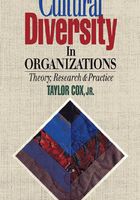
Preface
In this book I have assembled learnings from ten years of teaching, research, and consulting related to the topic of cultural diversity in organizations.
My objective in creating the book was to provide a comprehensive text that would be useful as an aid for teaching, organization development, and scholarship. My primary targets are teachers and students of diversity, whether they are on university campuses or in the classrooms of business and community organizations. I also hope that Cultural Diversity in Organizations will be found useful by organizational scholars seeking to build a foundation for—or to extend—their own ideas and research directions on topics related to diversity in organizations.
Useful Features of This Book
There are several features of the book that I believe will make it especially useful to readers. One is that the book is developed around a specific conceptual model that frames the issues in a systematic way. The model represents my attempt to communicate dimensions and dynamics of diversity, which are generic issues across many types of group identities. Hence I do not have separate chapters on gender, race, age, and so on. Instead, I have attempted to integrate examples using the group identities throughout the book as various aspects of the model are discussed.
A second feature is that the book addresses the topic on three levels of analysis: the individual, the group, and the organization. I believe this multidimensional approach comes closer to capturing the enormous complexity of the topic than would be true if only one perspective were emphasized. This complexity exacts a price: it was not feasible to present a thorough discussion of all the relevant literature on each aspect of the model. Thus the book is intended to give examples of pertinent theory and research on the points raised rather than provide definitive coverage of individual topics.
Third, the book provides what I hope is a substantive and fairly comprehensive treatment of the topic, applying knowledge collected from several fields of inquiry to the organizational context. A considerable amount of relevant theory and empirical research is reviewed, which I believe makes clear that there is a base of knowledge that we can use to inform teaching, organizational interventions, and future research related to diversity in the workforce. The liberal use of references in the book is intended to aid further study of specific issues.
Overview of the Contents
Part One opens with a chapter that explains what I mean by cultural diversity and presents my conceptual model of diversity (the Interactional Model of Cultural Diversity), on which much of the book is based. Chapters Two and Three make the case for why managing diversity is among the most important management challenges of this decade. These chapters should increase the reader’s motivation to study the material presented in Parts Two through Four.
Parts Two, Three, and Four explain how gender, race, nationality, and other cultural diversity dimensions influence organizational behaviors and outcomes. I have attempted to write these segments in such a way that readers will gain important insights into the complex social and psychological phenomena that underlie diversity, as well as how they are manifested in the work setting. This dual purpose reflects my strong belief that personal and organizational excellence in working with and leading diverse groups of workers will only be achieved if we are educated about the phenomena themselves as well as their practical implications. For example, I think it is important to help people understand not just that stereotyping hinders people from working together, but also such things as what stereotyping is, why people do it, and why it is different from acknowledging and valuing differences.
A distinctive feature throughout the book (except in Part Five) is that major learning points are summarized in proposition statements at the end of each chapter. These statements might be used by teachers and workshop facilitators to frame discussion questions, class exercises, exam questions, or for other learning objectives. Also, scholars interested in research on diversity may find them useful to stimulate ideas for future research agendas.
Finally, in Part Five, two full chapters are devoted to a discussion of organization development for managing diversity. Suggestions are given for the design and implementation of organization change processes for enhancing the capability to manage diversity.
At the time of this writing, teaching, research, and organization change initiatives on cultural diversity are still in an early stage of development. More and more organization leaders are coming to realize that the potential creativity and problem-solving advantages of a culturally diverse workforce is a resource that remains grossly underutilized in most of the world. I hope that readers will share some of the excitement that I experienced in writing the book as I reflected on a future so ripe with opportunity.
Taylor Cox, Jr.
Ann Arbor, Michigan
May 1993